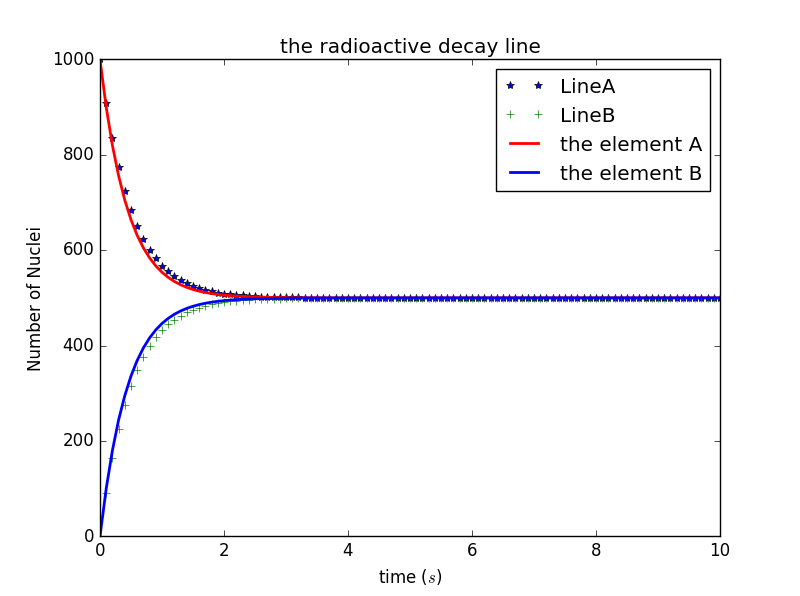@842001323
2016-10-07T09:34:36.000000Z
字数 4317
阅读 375
No.4
摘要
在处理物理问题时,经常会遇到微分方程。其中一阶常微分方程的初值问题数值解可由欧拉法求得。此次处理的问题是两种粒子由初始状态开始相互转化直至达到平衡,变换的过程将通过算法得以绘制成图,还将比较在不同初始值下曲线的变化及不同时间间隔下的曲线变化,再对程序进行检验。
背景介绍
欧拉法:铀的衰变方程为。的泰勒展开式为
所以
又
推得 已知,确定好取值,即可通过此式进行编程运算求解。类似的问题亦可如此解决。
A、B粒子的‘衰变’问题:A粒子可以转化为B粒子,B粒子也可以转化为A粒子。相应的转换速率方程为,。改变及的初始取值,取=1s,来验证系统会达到平衡状态,及为常数。
正文
取初始=1000,=0,=1s,=0.01s,总的时间为10s。
import pylab as pl class two_types_nuclei_decay: """ Simulation of a decay problem with two types of nuclei A and B """ def __init__(self, number_of_nucleiA = 1000, number_of_nucleiB =0, time_constant = 1, time_of_duration = 10, time_step = 0.01): self.na = [number_of_nucleiA] self.nb = [number_of_nucleiB] self.t = [0] self.tau = time_constant self.time = time_of_duration self.dt = time_step self.nsteps = int(time_of_duration // time_step + 1) print("Initial number of nuclei A ->", number_of_nucleiA) print("Initial number of nuclei B ->", number_of_nucleiB) print("Time constant ->", time_constant) print("time step -> ", time_step) print("total time -> ", time_of_duration) def calculate(self): for i in range(self.nsteps): tmp = self.na[i] - self.na[i] / self.tau * self.dt + self.nb[i] / self.tau * self.dt self.na.append(tmp) tmd = self.nb[i] - self.nb[i] / self.tau * self.dt + self.na[i] / self.tau * self.dt self.nb.append(tmd) self.t.append(self.t[i] + self.dt) def show_results(self): pl.plot(self.t,self.na,color='red',linewidth=2.0,linestyle='-',label='the element A') pl.plot(self.t,self.nb,color='blue',linewidth=2.0,linestyle='-',label='the element B') pl.legend(loc='upper right',frameon=True) pl.title('the radioactive decay line') pl.xlabel('time/s') pl.ylabel('number of nuclei') pl.plot([0,10],[500,500],linewidth=1.0,linestyle='--') pl.annotate(r'$(500.0)$', xy=(8,500.0),xycoords='data', xytext=(+10,+30),textcoords='offset points',fontsize=16, arrowprops=dict(arrowstyle="->",connectionstyle="arc3,rad=.2")) pl.show() b = two_types_nuclei_decay(number_of_nucleiA=1000, time_constant=1) b.calculate() b.show_results() c = two_types_nuclei_decay(number_of_nucleiB=0, time_constant=1) c.calculate() c.show_results()绘得相应图像

- 程序运行后的显示数值

- 改变相应的取值后 取初始=400,=600,=1s,=0.01s,总的时间为10s。
- 绘得相应图像

- 程序运行后的显示数值

- 取初始=400,=600,=2s,=0.01s,总的时间为10s
- 绘得相应图像

- 对程序测试:
由所给出的方程,,可解得
N为粒子总数 相应的程序(直接添加在原程序后)
from math import * class exact_results_check(two_types_nuclei_decay): def show_results(self): self.ea = [] self.eb = [] for i in range(len(self.t)): tema = (self.na[0]+self.nb[0])*0.5 + (self.na[0]-self.nb[0]) * exp(-2* self.t[i] / self.tau)*0.5 temb = (self.na[0]+self.nb[0])*0.5 - (self.na[0]-self.nb[0]) * exp(-2* self.t[i] / self.tau)*0.5 self.ea.append(tema) self.eb.append(temb) pl.plot(self.t, self.ea, '*', label='LineA') pl.plot(self.t, self.eb, '+', label='LineB') pl.plot(self.t,self.na,color='red',linewidth=2.0,linestyle='-',label='the element A') pl.plot(self.t,self.nb,color='blue',linewidth=2.0,linestyle='-',label='the element B') pl.legend(loc='upper right',frameon=True) pl.xlabel('time ($s$)') pl.ylabel('Number of Nuclei') pl.title('the radioactive decay line') pl.xlim(0, self.time) pl.show() d = exact_results_check(number_of_nucleiA=1000,number_of_nucleiB=0, time_constant=1, time_step=0.1) d.calculate() d.show_results()绘得图片

- 最后改变step size,看结果是否一致
相应程序
class diff_step_check(two_types_nuclei_decay): def show_results(self, style = 'b'): pl.plot(self.t, self.na, style) pl.plot(self.t, self.nb, style) pl.title('the radioactive decay line') pl.xlabel('time ($s$)') pl.ylabel('Number of Nuclei') pl.xlim(0, self.time) from pylab import * b = diff_step_check(number_of_nucleiA=1000,number_of_nucleiB =0, time_constant=1, time_step=0.25) b.calculate() b.show_results('b') c = diff_step_check(number_of_nucleiA=1000,number_of_nucleiB =0, time_constant=1, time_step=0.01) c.calculate() c.show_results('r') show()- 运行结果图

红线:stepsize=0.01,蓝线:stepsize=0.25
step改变后,曲线的大致走向和结果不变,细节部分数值有所改变。
结论
由上面的运行结果可知系统经过弛豫时间后达到平衡,及保持为常数。通过校验及step的改变,可以看出欧拉法能够较好的拟合实际的曲线,当step越小绘出的曲线越接近实际曲线。
致谢
- 老师提供的完整编码
- 13级强雨学长绘图部分的编码
